Synaptolepis oliveriana
Synaptolepis oliveriana Gilg
Family: Thymelaeaceae
Common names: chalk-stick root (Eng); uvuma omhlophe (isiZulu)
Introduction
Synaptolepis oliveriana is a much-branched, scrambling shrub, with spear-shaped leaves and sweetly scented, creamy yellow flowers in summer; the plant arises from very distinctive and highly medicinal, large, white roots.
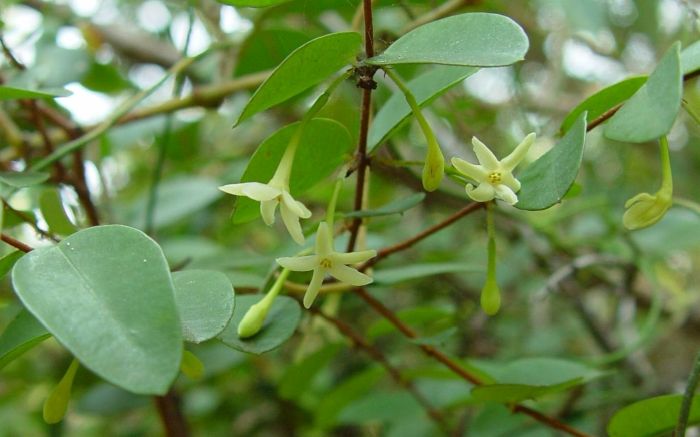
Description
Description
Synaptolepis oliveriana is an erect, multi-stemmed, scrambling shrub up 2 m tall and often twining around other plants for support. The bark is dark brown, flaky, fibrous. Branches are tough, brown or blackish, hairless, young branches sometimes have red or brown dots (lenticels), which become more prominent and wart-like on mature branches. The leaves are simple, opposite, 8–24 × 5–15 mm long, hairless, shiny dark green above, paler below. Margin entire, thickened; midrib not clearly visible above, prominently raised below, with parallel veins right up to the margin or ending before the margin.
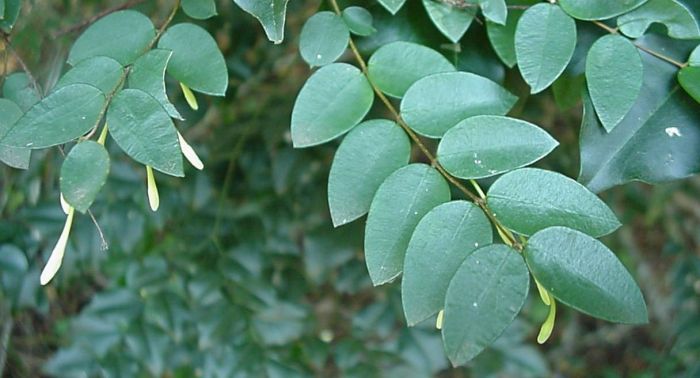
Flowers are small, solitary or in pairs, in leaf axils, sweetly scented, creamy yellow. The flower is a funnel-shaped tube, 10–15 mm long with elliptic lobes, 3.5–5.0 × 1.0–2.0 mm. The stamens are in the throat. The disc is cup-shaped. Flowering is in summer (October to March). Fruit is a drupe, 12 × 10 mm, enclosed in the persistent, fleshy base of the flower, yellowish to orange, turning blackish.
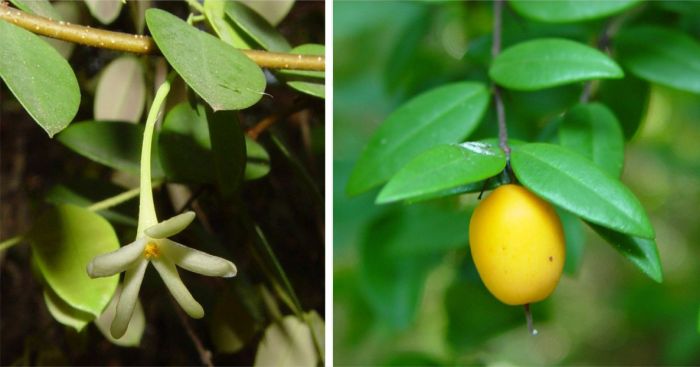
Conservation Status
Status
Synaptolepis oliveriana is Red Listed as Near Threatened (NT) in South Africa. According to the Red List of South African plants website, past exploitation for the medicinal plant trade has caused a decline of over 30% of the South African portion of the population. Declines caused by muthi harvesting and habitat destruction are ongoing. The assessment was downgraded to NT because there are adjacent and continuous subpopulations in southern Mozambique and Eswatini (formerly Swaziland).
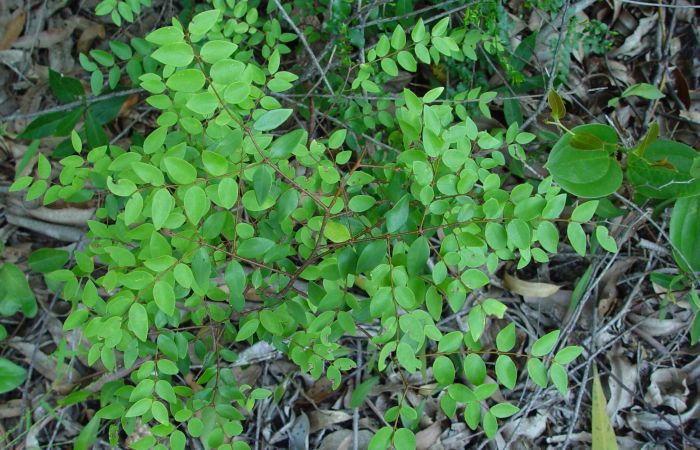
Distribution and habitat
Distribution description
Synaptolepis oliveriana is distributed in low altitudes in the far northern parts of KwaZulu-Natal in South Africa, and in Eswatini and southern Mozambique. It occurs mainly in the Maputaland Centre of Endemism. It is usually found in sand forest, bush clumps in dry coastal grassland and thicket on coastal dunes.
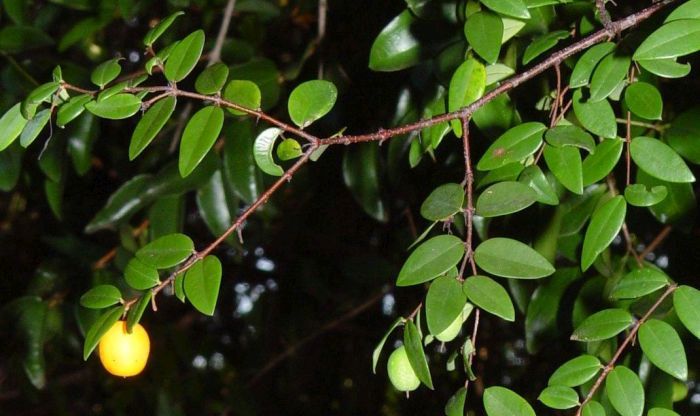
Derivation of name and historical aspects
History
The name of the genus Synaptolepis is derived from the Greek synaptos, meaning ‘joined together’ and lepis, ‘a scale’, and refers to the disc that is composed of scales. This species is named after Daniel Oliver (1830–1916), British botanist, Keeper of the Kew Herbarium for 26 years, Professor of Botany at University College London (1861–1888) and author of Flora of Tropical Africa (1868–1877).
Synaptolepis belongs to the Thymelaeaceae, commonly known as the fibre-bark or gonna family. This family is characterized by a strong, stringy, fibrous bark, and leaves that are simple, opposite or alternate and without stipules. This family has about 50 genera and 700 species and is found mainly in Africa, Mediterranean countries and Australia. There are 5 species of Synaptolepis, 4 occur in Africa, 1 in Madagascar and in South Africa Synaptolepis oliveriana is the only species currently recognized.
Synaptolepis oliveriana was previously confused with Synaptolepis kirkii, and many of the southern African specimens were mis-identified and thought to be a southern population of S. kirkii, which occurs in Kenya, Somalia and Tanzania. A 2006 study found that all the Mozambique specimens thought to be S. kirkii proved to be S. oliveriana, and S. kirkii is now considered to be confined to East Africa and all southern African specimens previously identified as S. kirkii are S. oliveriana.

Ecology
Ecology
Synaptolepis oliveriana produces sweetly scented, creamy yellow flowers that attract insects, including bees and butterflies, which assist with pollination. The fruits are eaten by birds. This species has a large root system; it can survive burning by fire, which can encourage new, seasonal growth.

Uses
Use
Synaptolepis oliveriana is one of the most identifiable species in medicinal markets because of its chalk-like, white roots which are heavily exploited for medicinal uses. Roots are traditionally used to induce visions and to assist the traditional diviners to have clarity in their trance vision, and to relieve anxiety and induce sleep. One website reports that it is believed that the roots of Synaptolepis oliveriana give the ability to connect one with his or her ancestors, which culminates in prophetic dreams and affords the diviners the ability to obtain answers to particular questions. An infusion of roots is used treat epilepsy and snakebite. The fruits are edible and can be eaten as a snack. The stem can be used as a rope.

Growing Synaptolepis oliveriana
Grow
This species is still unknown in cultivation. Geoff Nichols has had success propagating Synaptolepis oliveriana from seed, germinated in normal seedling mix. He removed the fleshy outer cover and sowed the seed on the day after collection. It took about 10 days to germinate. He has never tried to propagate this species from cuttings (Nichols 2015). This species would need a sunny position, in well-drained soil and it should be able to withstand some frost.
References
- Charters, M.L. 2006–2016. The Eponym Dictionary of South African plants. Published online at http://www.calflora.net/southafrica/1Titlepage.html
- Cleversley, K, 2002. Synaptolepis kirkii – uvuma-omhlope. http://entheology.com/plants/synaptolepis-kirkii-uvuma-omhlope/. Accessed 1 Sep 21
- Hutchings, A., Scott, A.H., Lewis, G. & Cunningham, A.B. 1996. Zulu medicinal plants: an inventory. University of Natal Press, Pietermaritzburg.
- Jordaan, M. & Bredenkamp, C.L. 2009. Thymelaeaceae: The true identity of Synaptolepis kirkii. Bothalia 39(1): 104–106.
- Nichols, G. 2005. Growing rare plants: a practical handbook on propagating the threatened plants of southern Africa. Southern African Botanical Diversity Network Report No. 36.
- Plants of the World Online. Synaptolepis Oliv. http://www.plantsoftheworldonline.org/taxon/urn:lsid:ipni.org:names:39333-1. Accessed 1 Sep 21.
- Pooley, E. 1998. A field guide to wild flowers Kwazulu-Natal and the eastern region. Natal Flora Publications Trust, Durban.
- Useful Tropical Plants. Synaptolepis kirkii. http://tropical.theferns.info/viewtropical.php?id=Synaptolepis+kirkii. Accessed 2021/08/14.
- Von Ahlefeldt, D., Crouch, N.R., Nichols, G., Symmonds, R., McKean, S., Sibiya, H. & Cele, M.P. 2003. Medicinal plants traded on South Africa’s eastern seaboard. Ethekwini Parks Dept. Durban.
- Williams, V.L., Raimondo, D., Crouch, N.R., Cunningham, A.B., Scott-Shaw, C.R., Lötter, M. & Ngwenya, A.M. 2013. Synaptolepis oliveriana Gilg. National Assessment: Red List of South African Plants version 2020.1. Accessed 2021/08/21
Credits
Lungisani Zondi
Walter Sisulu National Botanical Garden
September 2021
Acknowledgements: the author thanks Geoff Nichols for providing the images.
Plant Attributes:
Plant Type: Scrambler, Shrub
SA Distribution: KwaZulu-Natal
Soil type: Sandy
Flowering season: Early Summer, Late Summer
PH:
Flower colour: White, Cream, Yellow
Aspect: Full Sun, Morning Sun (Semi Shade), Afternoon Sun (Semi Shade)
Gardening skill: Easy
Special Features:
Horticultural zones








Rate this article
Article well written and informative
Rate this plant
Is this an interesting plant?
Login to add your Comment
Back to topNot registered yet? Click here to register.